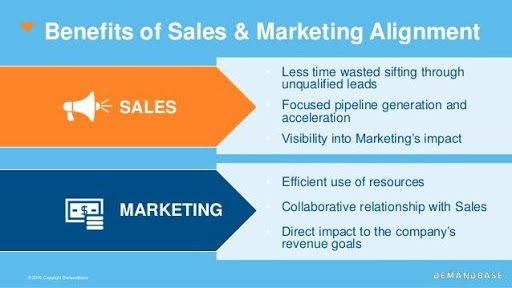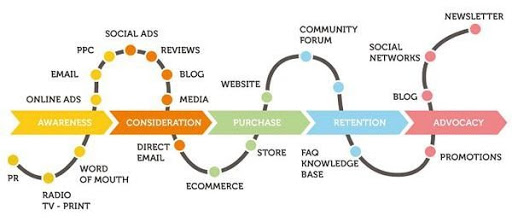Have you ever had to turn away a client because you’re already booked for a particular slot only to...
5 Top Tips to Improve Your Sales and Marketing Alignment
If you’re running a successful business, sales and marketing alignment is a must. When both departments work closely together, you can improve process efficiency and ultimately ensure the business reaps the maximum benefits.
This article will look at five tips you can implement to help align your marketing and sales teams. But first, let’s discuss some of the varied benefits you will gather by aligning the activities and goals of the two departments.
How Sales and Marketing Alignment Helps
Businesses that align their sales and marketing departments optimize their marketing and sales cycles as a whole. When marketers notify sales personnel about potential customers, sales representatives can improve conversions by nurturing those marketing leads. That does not just lead to a higher conversion rate, but also improves customer retention through continuous lead nurturing.
Similarly, when sales personnel inform marketers about what consumers are looking for before they eventually become customers, marketers can create content that appeals to consumers from the get-go and elicits the desired action. No marketing content goes to waste.
In other words, when your sales and marketing departments are aligned, they can create targeted campaigns that, in the end, help consumers move down the sales funnel.

Source: Demandbase
That translates to reduced costs and top-line growth.
The numbers back this up. According to Entrepreneur, sales and marketing alignment can result in a whopping 32% increase in year-over-year revenue growth. There’s revenue growth in each department, too; a 208% growth in marketing revenue, according to Marketo, and 38% higher sales win rates, based on data from Marketingprofs.
When you focus on sales and marketing alignment, you can expect to achieve – even exceed – your department goals and, by extension, your business goals, too!
How to Align Sales and Marketing
Now that you know the importance of aligning your sales and marketing departments let’s look at how that can be done. It doesn’t matter if you’re running an eCommerce website, managing a brick-and-mortar, store, or both. Getting your sales and marketing departments to follow the best practices below will ensure they are on the same page all the time.
Set Shared Goals
Each department will have different, even opposing, goals. The sales department’s goals, for example, will center on customer revenues. On the other hand, the marketing team will aim to increase web traffic or increase social media following.
That doesn’t mean, however, that the two departments can no longer sit together and determine shared objectives. After all, the goal of both departments is to increase the company’s revenue.
For example, the sales department may want to improve sales conversions by creating better landing pages with more targeted content. On the flip side, the marketing department may want to execute better social media campaigns to translate to sales.
Both might have the same aims, but if one department’s campaign reduces the effectiveness of whatever the other department is doing, you need to get them to discuss the next steps. These steps include setting a shared set of goals.
Once they set those shared goals, they need to set their key performance indicators (KPIs) together. They will help your sales and marketing departments determine whether or not they’re on track to achieving those shared goals they set out to achieve in the first place.
Conversion rate and lead value, for example, are KPIs both the sales and marketing teams can evaluate their campaigns against.
Create a Single Customer Journey
Your sales and marketing departments shouldn’t have different interpretations of the customer journey. But let’s back up a bit. What exactly is the customer journey?
The customer journey is the sum of all interactions a consumer has with your brand, from the initial stage of awareness to purchase, all the way to advocacy.

Source: Freshworks
Creating a customer journey map is critical because of two things. Firstly, it ensures a holistic customer experience. Secondly, it helps departments determine which elements work to move leads down the sales funnel. If your marketing and sales departments create the customer journey map together, they can develop strategies that will help the lead move down the sales funnel seamlessly.
For instance, both sales and marketing could create a customer journey map that starts with the customer becoming aware of the brand through social media (which is a function of marketing), then talking with a sales representative about the product’s features (sales). Once the customer makes a purchase, the company’s content marketing team can then send content designed to convert the buyer into a brand advocate (we’ll get to that later).
If both departments are on the same page, you can avoid scenarios where your marketing department highlights calls to action in campaigns that don’t align with customer experiences. For instance, if your sales research shows that most customers decide to purchase after being given a sales demo, offering a free trial option on your website won’t be very effective.
Work Together on the Post-Sales Experience
Your sales and marketing departments shouldn’t just work together to generate leads and conversions. They should work together to retain customers, too. Remember, it’s much cheaper to retain customers than to acquire new ones. Also, according to Annex Cloud, a mere 5% increase in customer retention can increase profits by up to 95%.
How exactly can sales and marketing departments work together on the post-sales experience? For starters, sharing customer information will go a long way.
Let’s say a prospect becomes a customer. The sales department should inform the marketing department of the development so marketing can tailor its marketing campaigns. The marketing department can send messages that nurture the relationship with a prospective client. For example, they could send product updates, best practices for getting the most out of the purchase, or general industry-centric tips, etc.
This is where customer segmentation will prove to be very useful. Dividing your customers according to industry, location, role, or interests will help both teams create useful, relevant content. For example, you’ll send different types of content for academic, commercial, or industrial clients.
Aside from sending customer retention content, you may also send upselling or cross-selling messages. The marketing department should inform the sales department immediately if a customer expresses an interest in upgrading their purchased product. This will allow the sales department to answer any queries immediately and assist with the upsell.
Monitor Customer Feedback for Each Other
Successful businesses use customer feedback to their advantage. They don’t view negative customer feedback as a hindrance to growth. Instead, they use it to improve business processes and products to ultimately better serve their customers.
Although your sales and marketing departments can technically monitor customer feedback separately for each department’s benefit, they can do much more if they monitor it for each other.
Let me give you a scenario. Let’s say your marketing department comes across a comment on social media complaining about the company’s sales personnel giving very short product demos. If the marketing department were just monitoring customer feedback for its benefit, it would have just moved past the comment.
If, however, it was also monitoring feedback that can help the sales department, that comment would have been a red flag, and marketing would have immediately informed the sales department about the complaint.
Similarly, the sales department wouldn’t just ignore a customer’s complaint about how difficult it is to find the company opt-in form on the website. It would immediately notify the marketing department, so designated marketers can make the necessary web improvements.
Coordinate Brand Messaging
Make sure your sales and marketing departments coordinate brand messaging. While each department can run its own campaign separately, they should at least inform the other about the types of brand messages being used throughout each other’s campaign.
This is important because it can help ensure consistent messaging across marketing and sales platforms. Consumers appreciate it when brands are consistent. A Lucidpress study found the consistent presentation of a brand increases revenue by 33%, mostly because the customer knows what to expect of the brand at any given point in the customer journey.
If the marketing department sends marketing emails that are casual in tone, sales representatives should adopt the same demeanor when talking to customers. If the marketing department emphasizes authoritativeness and bombards consumers with statistics and facts, sales representatives should do the same.
Both departments should show that they belong to the same company. When you show a consistent face to consumers, it gives you better brand recognition and increases the chances of conversion.
Bottom Line
Sales and marketing alignment is critical to your business’ success. If your sales and marketing departments are not on the same page, you can’t expect your business to reap the maximum benefits.
By aligning your sales and marketing departments, you ensure that the customer journey is consistent, from lead generation to the purchase point. Both departments should also work together on the post-sales experience, whether it involves upselling or creating customer loyalty through useful content.
When your sales and marketing departments work separately, your company isn’t likely to get anywhere. However, when the two units start collaborating on creating a seamless customer journey and providing a consistent experience and presence, you can expect your business to achieve – or even exceed – your goals.






Blog comments